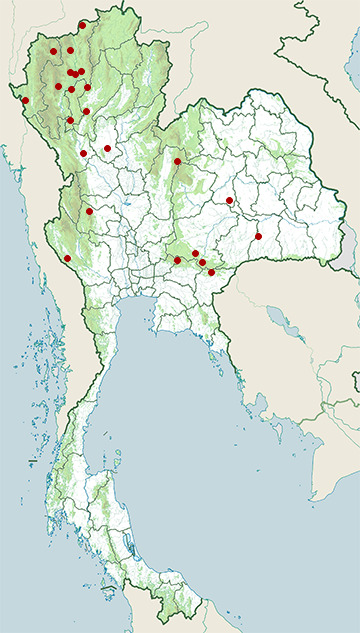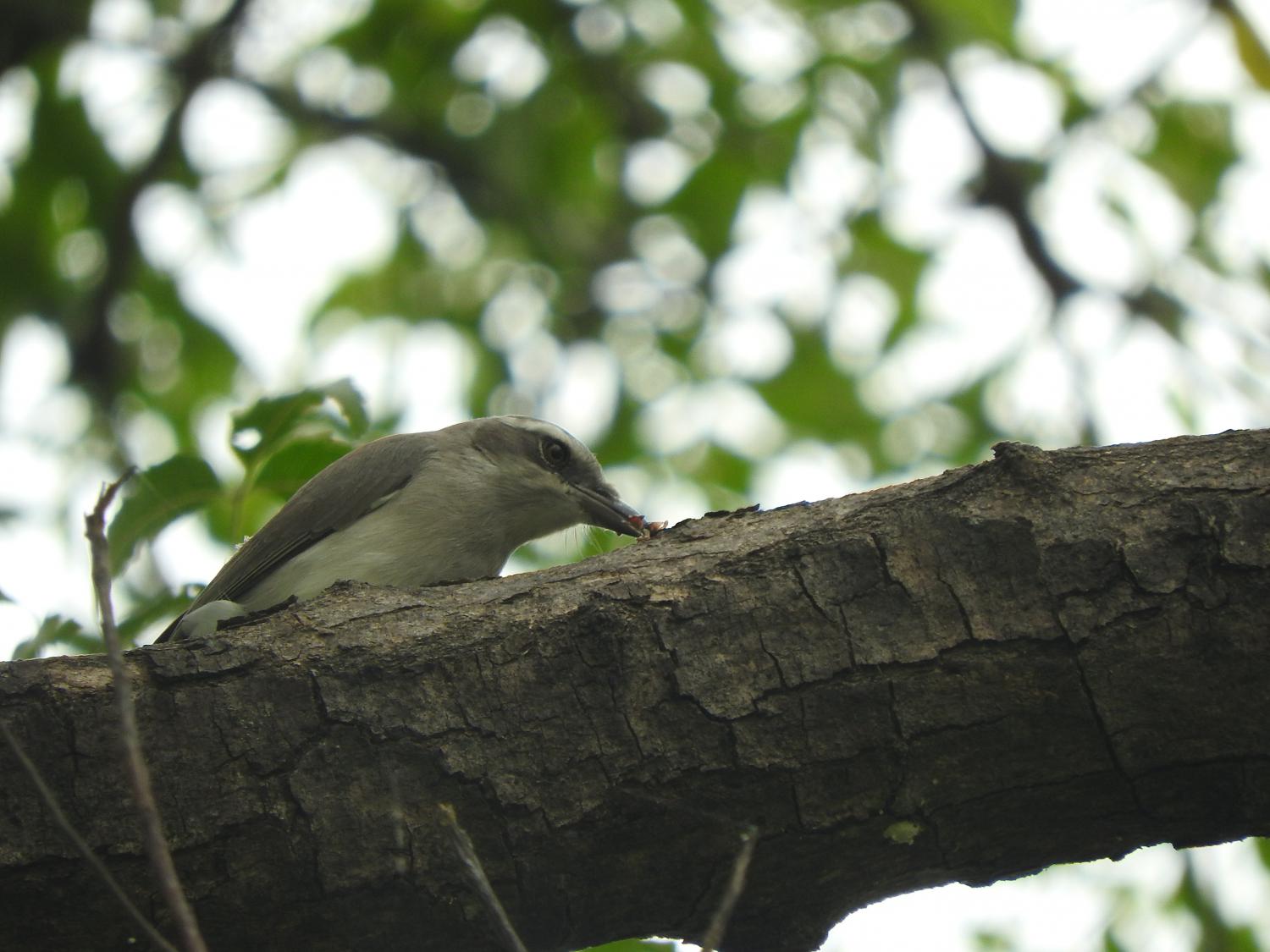Species of Thailand
Common woodshrike
Tephrodornis pondicerianus
Johann Friedrich Gmelin, 1789
In Thai: นกเฉี่ยวดงธรรมดา, นกเฉี่ยวดงคิ้วขาว
The common woodshrike (Tephrodornis pondicerianus) is a species of bird found in Asia. It is now usually considered a member of the family Vangidae. It is small and ashy brown with a dark cheek patch and a broad white brow. It is found across Asia mainly in thin forest and scrub habitats where they hunt insects, often joining other insectivorous birds. The form found in Sri Lanka which was treated as a subspecies is now usually considered a separate species, the Sri Lanka woodshrike.
Description
The common woodshrike is dully ashy brown and like other woodshrikes has a large head with a strong hooked beak. They have a broad creamy brow above a dark cheek patch and white outer tail feathers contrasting with their dark tail. Young birds have streaks and spot on the crown and white spots on the mantle. The underside is also streaked and the breast is heavily marked in young birds. The Sri Lankan species is similar darker on the underside, with the dark cheek bordered below by a buffy sub-moustachial stripe and a white rump.
Taxonomy
The genus name Tephrodornis is derived from the Greek root tephra (τέφρα) which refers to ash, the colour and ornis for bird. The species was described by J.F. Gmelin on the basis of a specimen that came from the Coromandel region, presumably Pondicherry on the basis of which he gave the species name. Claud Ticehurst however restricted the type locality of the nominate subspecies to Madras. He placed it along with the flycatchers in the genus Muscicapa. In the past the species included Tephrodornis affinis as a subspecies but that is now considered a full species restricted within Sri Lanka. The Sri Lankan species has distinct plumage as well as calls. Several subspecies have been named for the populations within the wide range of this species. The northwestern dry region form is paler and given the name of pallidus while the nominate population which has dark central tail feathers is found in peninsular India. The populations in Southeast Asia are placed in orientis.
Behaviour and ecology
Usually found in pairs, they have a loud whistling song made of several notes. The usual call is a plaintive weet-weet followed by a series of quick whi-whi-whi-whee?. They have a loud song consisting of several rapid whistling notes. They feed on mainly on insects and sometimes berries by gleaning mostly along branches and leaves within trees but sometimes also make aerial sallies or descend to the ground. They have a habit of adjusting their wings, raising them over the tail shortly after alighting on a perch. They nest in summer before the rainy season, building a cup nest on a bare fork. The nest is made of fibres and bark held by cobwebs and covered with bits of bark and lichen. It is lined with silky plant fibres. Three eggs are the usual clutch. Both parents incubate but it is thought that only the female feeds the young. Young birds are fed on insects and berries. Two broods may be raised in some years.
A species of Haemoproteus was described from a Goan specimen of this species as Haemoproteus tephrodornis by Froilano de Mello in 1935. A spirurid nematode Oxyspirura alii was described and named after S. Mehdi Ali and obtained from within the eye cavity of a common woodshrike specimen from Hyderabad. Ticks of the species Haemaphysalis bispinosa and H. intermedia have been recorded on the species.
This article uses material from Wikipedia released under the Creative Commons Attribution-Share-Alike Licence 3.0. Eventual photos shown in this page may or may not be from Wikipedia, please see the license details for photos in photo by-lines.
Category / Seasonal Status
BCST Category: Recorded in an apparently wild state within the last 50 years
BCST Seasonal status: Resident or presumed resident
Scientific classification
- Kingdom
- Animalia
- Phylum
- Chordata
- Class
- Aves
- Order
- Passeriformes
- Family
- Vangidae
- Genus
- Tephrodornis
- Species
- Tephrodornis pondicerianus
Common names
- Thai: นกเฉี่ยวดงธรรมดา, นกเฉี่ยวดงคิ้วขาว
Photos
Please help us review the bird photos if wrong ones are used. We can be reached via our contact us page.
Range Map

- Chiang Dao Wildlife Sanctuary
- Doi Chong National Park
- Doi Inthanon National Park
- Doi Khun Tan National Park
- Doi Pha Hom Pok National Park
- Doi Saket District, Chiang Mai
- Doi Suthep - Pui National Park
- Huai Kha Khaeng Wildlife Sanctuary
- Khao Yai National Park
- Mae Ping National Park
- Mueang Chiang Mai District, Chiang Mai
- Mueang Sukhothai District, Sukhothai
- Mueang Surin District, Surin
- Mueang Tak District, Tak
- Nam Nao National Park
- Nong Song Hong District, Khon Kaen
- Pa Sang District, Lamphun
- Pai District, Mae Hong Son
- Pang Sida National Park
- Sai Yok National Park
- Sakaerat Environmental Research Station
- Salawin National Park
- Thap Lan National Park


